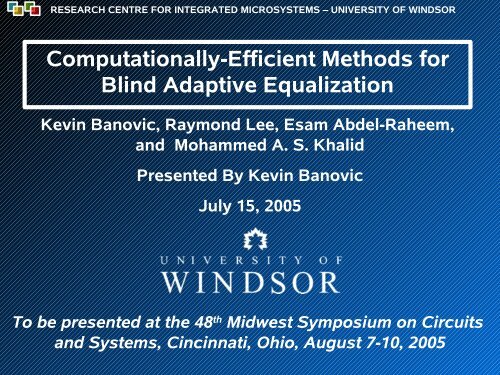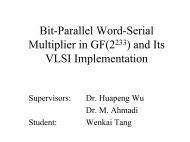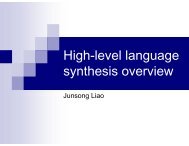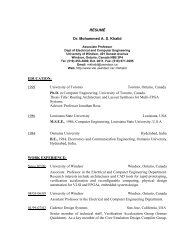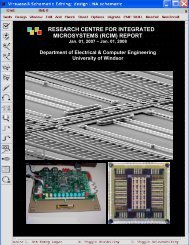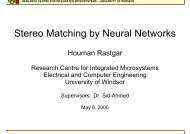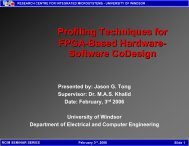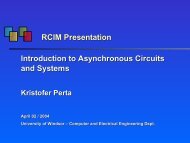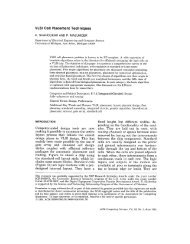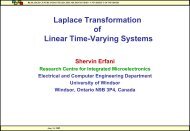Computationally-Efficient Methods for Blid Adaptive Equalization
Computationally-Efficient Methods for Blid Adaptive Equalization
Computationally-Efficient Methods for Blid Adaptive Equalization
You also want an ePaper? Increase the reach of your titles
YUMPU automatically turns print PDFs into web optimized ePapers that Google loves.
RESEARCH CENTRE FOR INTEGRATED MICROSYSTEMS – UNIVERSITY OF WINDSOR<br />
<strong>Computationally</strong>-<strong>Efficient</strong> <strong>Methods</strong> <strong>for</strong><br />
Blind <strong>Adaptive</strong> <strong>Equalization</strong><br />
Kevin Banovic, Raymond Lee, Esam Abdel-Raheem,<br />
and Mohammed A. S. Khalid<br />
Presented By Kevin Banovic<br />
July 15, 2005<br />
To be presented at the 48 th Midwest Symposium on Circuits<br />
and Systems, Cincinnati, Ohio, August 7-10, 2005
RESEARCH CENTRE FOR INTEGRATED MICROSYSTEMS – UNIVERSITY OF WINDSOR<br />
Outline<br />
1. Introduction<br />
2. <strong>Computationally</strong>-<strong>Efficient</strong> <strong>Methods</strong><br />
3. Proposed Selective Update Method<br />
4. Simulation Results<br />
5. Conclusions<br />
6. References<br />
KEVIN BANOVIC RCIM SEMINAR<br />
Slide 2
RESEARCH CENTRE FOR INTEGRATED MICROSYSTEMS – UNIVERSITY OF WINDSOR<br />
Introduction<br />
<br />
<br />
<br />
<br />
Blind adaptive equalization is used in systems where the<br />
transmission of a training sequence is impractical<br />
Common blind algorithms include the reduced constellation<br />
algorithm (RCA), the constant modulus algorithm (CMA),<br />
and the multimodulus algorithm (MMA)<br />
<strong>Equalization</strong> can consume in excess of 80% of the total<br />
arithmetic computations needed to demodulate a<br />
transmitted symbol sequence into binary words, which has<br />
resulted in a number of computationally-efficient methods<br />
We present a survey of efficient methods <strong>for</strong> blind<br />
equalization and propose a new method that selectively<br />
updates the equalizer taps based on the equalizer output<br />
radius <strong>for</strong> QAM signal constellations<br />
KEVIN BANOVIC RCIM SEMINAR<br />
Slide 3
RESEARCH CENTRE FOR INTEGRATED MICROSYSTEMS – UNIVERSITY OF WINDSOR<br />
Outline<br />
1. Introduction<br />
2. <strong>Computationally</strong>-<strong>Efficient</strong> <strong>Methods</strong><br />
3. Proposed Selective Update Method<br />
4. Simulation Results<br />
5. Conclusions<br />
6. References<br />
KEVIN BANOVIC RCIM SEMINAR<br />
Slide 4
RESEARCH CENTRE FOR INTEGRATED MICROSYSTEMS – UNIVERSITY OF WINDSOR<br />
<strong>Computationally</strong>-<strong>Efficient</strong> <strong>Methods</strong><br />
<br />
<br />
<br />
<br />
<strong>Adaptive</strong> filtering consists of two operations: convolution of<br />
the received symbol sequence with the tap coefficients<br />
and updating the tap coefficients<br />
For an adaptive FIR filter of length M, each of the previous<br />
operations require 4M multiplications <strong>for</strong> a total of 8M<br />
multiplications when the received signal is complex<br />
One method to improve computational efficiency is to<br />
simplify or reduce the amount of multiplications<br />
Our focus is the reduction of multiplications in the<br />
equalizer tap update and we consider the signed-error,<br />
dithered signed-error, quantized-error, block, and update<br />
decimation methods<br />
KEVIN BANOVIC RCIM SEMINAR<br />
Slide 5
RESEARCH CENTRE FOR INTEGRATED MICROSYSTEMS – UNIVERSITY OF WINDSOR<br />
<strong>Adaptive</strong> FIR Filter Structure<br />
Figure 1: <strong>Adaptive</strong> FIR filter <strong>for</strong> real input samples<br />
KEVIN BANOVIC RCIM SEMINAR<br />
Slide 6
RESEARCH CENTRE FOR INTEGRATED MICROSYSTEMS – UNIVERSITY OF WINDSOR<br />
Signed-Error Method<br />
<br />
<br />
<br />
Only the sign of the respective error signal is retained<br />
When coupled with a power-of-two stepsize, a multiplyfree<br />
fixed-point equalizer tap update can be realized<br />
reducing the total multiplications by a factor of two<br />
The general signed-error tap update algorithm is:<br />
<br />
Signed-error algorithms are straight <strong>for</strong>ward to implement<br />
and have been proposed <strong>for</strong> RCA and CMA, and can be<br />
extended to MMA<br />
KEVIN BANOVIC RCIM SEMINAR<br />
Slide 7
RESEARCH CENTRE FOR INTEGRATED MICROSYSTEMS – UNIVERSITY OF WINDSOR<br />
Dithered Signed-Error Method<br />
<br />
<br />
<br />
The convergence of signed-error CMA is not robust and is<br />
known to diverge<br />
This can be overcome by the application of a controlled<br />
noise or dither signal, which improves robustness<br />
The general dithered signed-error tap update algorithm is:<br />
<br />
Where α is a positive constant and d n<br />
is an independent<br />
identically distributed (i.i.d.) dithering process uni<strong>for</strong>mly<br />
distributed over (-1,1]<br />
KEVIN BANOVIC RCIM SEMINAR<br />
Slide 8
RESEARCH CENTRE FOR INTEGRATED MICROSYSTEMS – UNIVERSITY OF WINDSOR<br />
Quantized-Error Method<br />
<br />
<br />
<br />
The error signal of the respective algorithm is quantized<br />
using a nonlinear power-of-two quantizer<br />
When coupled with a power-of-two stepsize the equalizer<br />
tap update becomes shift and add operations<br />
The general quantized-error tap update algorithm is:<br />
<br />
Where<br />
<br />
And τ is set to either 0 or 2 -B+1 and B is the data word length<br />
KEVIN BANOVIC RCIM SEMINAR<br />
Slide 9
RESEARCH CENTRE FOR INTEGRATED MICROSYSTEMS – UNIVERSITY OF WINDSOR<br />
Block Method<br />
<br />
<br />
A block of equalizer input samples and instantaneous error<br />
samples are used to update the tap coefficients once every<br />
L input samples, where L is the block length<br />
The general block tap update algorithm is:<br />
<br />
<br />
<br />
Estimates the gradient over L iterations, which allows a<br />
larger stepsize to be applied since the variance of a block of<br />
gradient updates is less than that <strong>for</strong> individual updates<br />
Can be implemented in frequency domain to increase rate<br />
of convergence<br />
Have been proposed <strong>for</strong> CMA and can be extended to MMA<br />
KEVIN BANOVIC RCIM SEMINAR<br />
Slide 10
RESEARCH CENTRE FOR INTEGRATED MICROSYSTEMS – UNIVERSITY OF WINDSOR<br />
Update Decimation Method<br />
<br />
<br />
The equalizer taps are updated once every k iterations,<br />
where k is a positive integer greater than one<br />
It is expected that update-decimated algorithms would<br />
obtain similar steady-state mean-squared error (MSE) with<br />
1/k times the computations, while taking k times the timeto-convergence<br />
KEVIN BANOVIC RCIM SEMINAR<br />
Slide 11
RESEARCH CENTRE FOR INTEGRATED MICROSYSTEMS – UNIVERSITY OF WINDSOR<br />
Outline<br />
1. Introduction<br />
2. <strong>Computationally</strong>-<strong>Efficient</strong> <strong>Methods</strong><br />
3. Proposed Selective Update Method<br />
4. Simulation Results<br />
5. Conclusions<br />
6. References<br />
KEVIN BANOVIC RCIM SEMINAR<br />
Slide 12
RESEARCH CENTRE FOR INTEGRATED MICROSYSTEMS – UNIVERSITY OF WINDSOR<br />
Selective Update Method<br />
<br />
<br />
The square decision region of an estimated symbol point<br />
in a QAM constellation is divided in two by a circular<br />
boundary, C b<br />
, which corresponds to radius R b<br />
Equalizer taps are updated only if R n<br />
> R b<br />
, where R n<br />
is the<br />
distance from the estimated symbol to the equalizer<br />
output defined as:<br />
<br />
The general selective update tap update algorithm is:<br />
<br />
where<br />
KEVIN BANOVIC RCIM SEMINAR<br />
Slide 13
RESEARCH CENTRE FOR INTEGRATED MICROSYSTEMS – UNIVERSITY OF WINDSOR<br />
Selective Update Method<br />
Figure 2: Decision regions <strong>for</strong> symbol estimates in 16-QAM (left)<br />
and decision regions <strong>for</strong> the selective update method (right).<br />
KEVIN BANOVIC RCIM SEMINAR<br />
Slide 14
RESEARCH CENTRE FOR INTEGRATED MICROSYSTEMS – UNIVERSITY OF WINDSOR<br />
Selective Update Method<br />
<br />
<br />
<br />
<br />
The outer region corresponds to adaptation phases with<br />
high MSE, while the inner region corresponds to<br />
adaptation phases with low MSE<br />
Initially, the MSE will be high and the outer region will be<br />
selected most of the time, allowing the transient response<br />
of the base algorithm to remain unchanged<br />
In slow time-varying channels, once the MSE has been<br />
reduced, the inner region will be selected most of the time,<br />
which will result in a drastic reduction of tap updates<br />
If the channel experiences sudden changes, the MSE will<br />
increase and the process will repeat<br />
KEVIN BANOVIC RCIM SEMINAR<br />
Slide 15
RESEARCH CENTRE FOR INTEGRATED MICROSYSTEMS – UNIVERSITY OF WINDSOR<br />
Outline<br />
1. Introduction<br />
2. <strong>Computationally</strong>-<strong>Efficient</strong> <strong>Methods</strong><br />
3. Proposed Selective Update Method<br />
4. Simulation Results<br />
5. Conclusions<br />
6. References<br />
KEVIN BANOVIC RCIM SEMINAR<br />
Slide 16
RESEARCH CENTRE FOR INTEGRATED MICROSYSTEMS – UNIVERSITY OF WINDSOR<br />
Simulation Parameters<br />
<br />
<br />
Discussed and proposed methods applied to CMA & MMA<br />
Simulations are in a 35dB SNR environment <strong>for</strong> 16-QAM<br />
using SPIB microwave channels (#1,2,4-6,8-10), with T/2-<br />
spaced FIR equalizers (16-tap, double 0.5 center spike)<br />
Applied stepsize of 2 -10 (except DSE-CMA which used 2 -11<br />
to avoid divergence), block length L=20, α=0.65<br />
<br />
<br />
R b<br />
<strong>for</strong> selective update method was chosen using an ad<br />
hoc approach and ranged between d/8 and d/12, where d<br />
is the distance between symbol points<br />
MSE calculated as instantaneous squared error over the<br />
slicer <strong>for</strong> 100-1000 iterations<br />
Graphical results shown <strong>for</strong> SPIB microwave channel #2<br />
KEVIN BANOVIC RCIM SEMINAR<br />
Slide 17
RESEARCH CENTRE FOR INTEGRATED MICROSYSTEMS – UNIVERSITY OF WINDSOR<br />
Simulation Results <strong>for</strong> CMA-Based Algorithms<br />
Figure 3: CMA simulation results.<br />
KEVIN BANOVIC RCIM SEMINAR<br />
Slide 18
RESEARCH CENTRE FOR INTEGRATED MICROSYSTEMS – UNIVERSITY OF WINDSOR<br />
Simulation Results <strong>for</strong> MMA-Based Algorithms<br />
Figure 3: MMA simulation results.<br />
KEVIN BANOVIC RCIM SEMINAR<br />
Slide 19
RESEARCH CENTRE FOR INTEGRATED MICROSYSTEMS – UNIVERSITY OF WINDSOR<br />
Simulation Results<br />
<br />
<br />
<br />
Quantitative results have been averaged over all channels<br />
In the table to follow, the MSE corresponds to the steadystate<br />
MSE, M is the misadjustment, and TTC is the timeto-convergence<br />
which was taken as the number of<br />
samples required to reach 90% of the steady-state MSE<br />
Misadjustment is the ratio of excess MSE (EMSE) to the<br />
minimum theoretical MSE (MMSE), where EMSE is the<br />
difference between the steady-state MSE and the MMSE<br />
KEVIN BANOVIC RCIM SEMINAR<br />
Slide 20
RESEARCH CENTRE FOR INTEGRATED MICROSYSTEMS – UNIVERSITY OF WINDSOR<br />
Quantitative Simulation Results<br />
Table 1: Quantitative Simulation Results.<br />
Proposed algorithms have the lowest misadjustment and same rate<br />
of convergence as original algorithms<br />
KEVIN BANOVIC RCIM SEMINAR<br />
Slide 21
RESEARCH CENTRE FOR INTEGRATED MICROSYSTEMS – UNIVERSITY OF WINDSOR<br />
Outline<br />
1. Introduction<br />
2. <strong>Computationally</strong>-<strong>Efficient</strong> <strong>Methods</strong><br />
3. Proposed Selective Update Method<br />
4. Simulation Results<br />
5. Conclusions<br />
6. References<br />
KEVIN BANOVIC RCIM SEMINAR<br />
Slide 22
RESEARCH CENTRE FOR INTEGRATED MICROSYSTEMS – UNIVERSITY OF WINDSOR<br />
Conclusions<br />
<br />
<br />
<br />
Simulations have confirmed that on average, the proposed<br />
selective update method achieves similar transient<br />
behavior and lower steady-state MSE and misadjustment<br />
than the original algorithm<br />
After convergence, the percentage of tap updates <strong>for</strong> the<br />
selective update method is considerably reduced (
RESEARCH CENTRE FOR INTEGRATED MICROSYSTEMS – UNIVERSITY OF WINDSOR<br />
Thank You!<br />
Questions or Comments?<br />
KEVIN BANOVIC RCIM SEMINAR<br />
Slide 24
RESEARCH CENTRE FOR INTEGRATED MICROSYSTEMS – UNIVERSITY OF WINDSOR<br />
References<br />
KEVIN BANOVIC RCIM SEMINAR<br />
Slide 25
RESEARCH CENTRE FOR INTEGRATED MICROSYSTEMS – UNIVERSITY OF WINDSOR<br />
References<br />
KEVIN BANOVIC RCIM SEMINAR<br />
Slide 26
RESEARCH CENTRE FOR INTEGRATED MICROSYSTEMS – UNIVERSITY OF WINDSOR<br />
References<br />
KEVIN BANOVIC RCIM SEMINAR<br />
Slide 27


